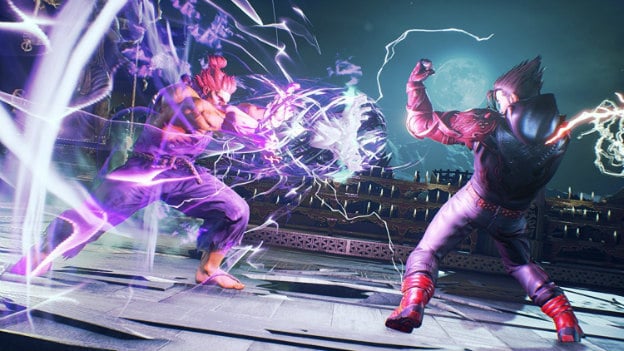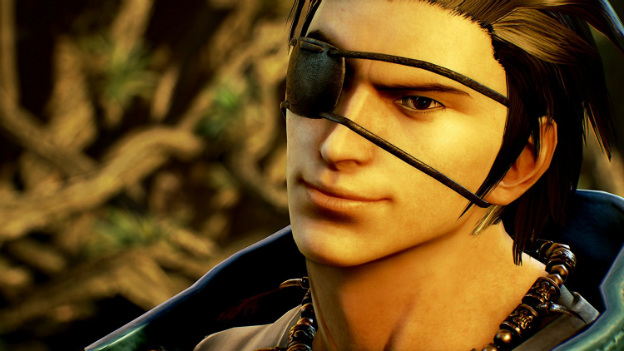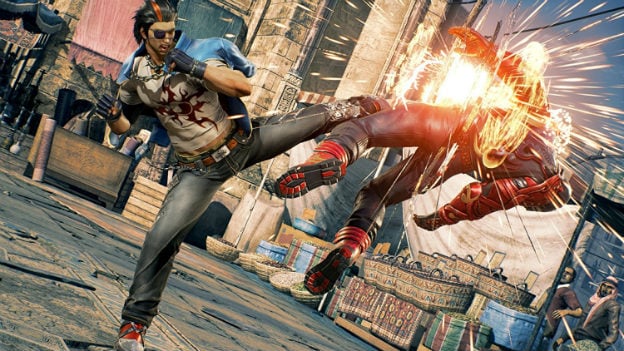Take Time to Try Tekken 7
There are few things in life that I love more than fighting games and pro wrestling. Street Fighter V delivered in a fun way with the 3D debut of Rainbow Mika, and Pikachu Libre was an excellent mascot for Pokken Tournament . Now, Tekken 7 has made dreams I didn’t know I had a reality, crossing over with the real-life New Japan Pro Wrestling. If I had my way, this review would be less about the general merits of Tekken 7 as a whole package and more about my new CHAOS vs Bullet Club headcanon war tearing its way across the game’s roster. Also, King having a full outfit based on IWGP champion Kazuchika Okada, complete with an alternative Rage Art, may be the best piece of nerdy fanservice in video game history.
Anyway, Tekken 7 is finally on consoles after a long run in Japanese arcades. It’s the first Tekken game with an elaborate story mode, inspired as usual by NetherRealm’s innovations of sorts with Mortal Kombat 9 . Similarly, Tekken 7 largely presents itself as a celebration of the whole series, with a ton of bonus gallery-like features that lets fans peruse tons of content from throughout the series’ history. This is the ultimate release for Tekken fans, although I fear that, despite a few gimmicky grasps at accessibility, this is not a super-friendly entry for newcomers.
I have a bit of a bone to pick with Tekken 7 in this regard. It also extends to this new trend of packing fighters with long, gimmicky story modes in response to casual fighting fans going absolutely bonkers over Mortal Kombat 9 ’s deal. This is not good for the genre. Dumping the player in a bunch of random fights, shifting between characters, and giving them a bunch of shortcuts will not teach them how to actually play the game. It only results in discouraging them from learning or playing against other human beings. These things are way too long, way too detrimental to the actual point of a fighting game, and most of the time offer several hours of bad writing anyway. Why do people like these?
I get it. Going too much in the other direction, catering to hardcores, and nobody will want to bother trying in the first place. That’s why Street Fighter V came off like such a disaster when it launched. But think about the long-lasting success of Street Fighter IV . All that game had was a classic-style arcade mode with openings and endings for each character. But it also had things like Challenge Mode, which was critical for that game’s success as well as a renewed interest in fighters as a Thing. Challenge Mode was essentially a super-thorough tutorial mode that taught players in a really intuitive way how to play Street Fighter . You went through a list of challenges that taught you each character’s basic moves and provided example combos. It rewarded you for completing each challenge, and by the time you got through, you were much better at the game.
Tekken 7 is an awful teacher. By nature, Tekken is an incredibly deep game with ridiculously long character move lists and all kinds of little mechanics and nuances that even diehard fans of other fighting games can struggle with. It is very much a beast of its own, not really playing by the rules of other fighting games. It doesn’t bother in the slightest to show you how to play in a satisfactory or accessible way. Story mode dumps you in and shows you how to throw a punch, then gives you little shortcuts to select moves you can throw out if you don’t know what you’re doing. You can also set it to casual mode and mash buttons to get little, automatic combos. If you go to training mode, you’re more or less on your own. You can have a move’s inputs display on the screen or watch a video preview of the move, but knowing how the timing works or other fundamentals is up to you, preferably via outside materials from pro players.
This is paired with some truly horrible AI balance that gets worse and worse as the story mode goes on. For something that is used in other ways to bring casual fans in, Tekken 7 expects you to know exactly what you’re doing by the end and develop inhuman reflexes and prediction skills along the way. Even on casual mode, the final boss and secret boss were a nightmare for me, a seasoned mid-level player. It’s frustrating and something Tekken has struggled with for a long time.

That said, Tekken itself is a great series once you figure it out, and Tekken 7 is a whole lot of that. Each character feels distinct and fun to mess around with. Once you find one or two that click with your style, learning them as you play is so much satisfying fun. It also isn’t afraid to be silly, often peppering characters like Panda and Kuma in with all the dour, serious, anime-nonsense, demon characters and fighting game tropes. The roster is nice and big and even has a huge, canon (!) appearance by Akuma from Street Fighter . Akuma is even kind of a secret accessibility tool, as his moveset kind-of reflects how Street Fighter plays. As a general Tekken outsider, I was able to pick Akuma and use him as a bit of a crutch as I familiarized myself this game.

While I can do without the goofy story mode, Tekken 7 strikes gold with its other single-player mode, Treasure Battle. The best part about the game is its character customization. While this has been a brewing feature for a while in the series, it really comes into its own this time. There are tons of options for each character, some universal and some unique. You can often alter things like hair styles and colors and even tweak the various clothing items a bit. In addition to the obvious, you’ll also unlock things like different hit effects, colored auras, and even alternative character select screen art. Tekken 7 also has a ton of different UI customization and profile options, from your little player tagline down to what your health bar looks like.
Treasure Battle is the delivery mechanism for all these little trinkets and goodies. It’s essentially a survival mode without the health-refilling gimmick. You just, you know, play some dang Tekken 7 for as long as you can stand it and get rewarded for nearly every battle you play. Along the way, you end up in special fights against boss-level characters or end up fighting in bizarre conditions that affect the speed or flow of the game. It’s single-player content, with incentives for continued play and more reasonable AI than what you end up with in story mode. It’s awesome and where I’ll find myself spending time if I’m not throwing down in-person with my friends.

I would also be remiss if I didn’t talk about Tekken 7 ’s dope gallery modes. Exclusive to the PlayStation 4 version is the Jukebox, which is a collection of music from literally all of Tekken . Every major release is represented here, and you can even go through and build your own playlists. The series has incredible music ( Tekken 7 is definitely no slouch here), and having access to all of it in one place is so cool! The Gallery mode proper is also neat and lets you spend in-game money (which flows without issue) on cutscenes from each game. This includes several CGI videos from a bunch of pachinko games, which is just hilarious. Each game also has a bunch of art, from character renders to concept art, and other bits of paraphernalia. With games like Mega Man Legacy Collection taking historical preservation in video games more seriously than ever, it’s awesome to see a big, AAA release do something similar.
Fans of Tekken should love Tekken 7 . There’s a ton to do, the roster is better than ever, and many of the new mechanics add even further to the depth and options players have at any given moment. The Treasure Battle mode and unlockable customization items add tons of hours and silly fun to Tekken 7 ’s shelf-life, and the unlockable gallery items show a level of care and dedication to Tekken as not only a franchise IP, but a long-lasting art with an important, meaningful history. On the other hand, I doubt the sloppy, incomprehensible story mode will do much for anyone who doesn’t care about, uh, Tekken lore, and a fighting game with the amount of depth Tekken has not having similar learning tools that most of the competition has is a glaring drawback. Ultimately, the core of Tekken is unlike anything else in the genre, and getting people together to figure it out and get your hands dirty is always a blast. Tekken 7 continues with the care and polish a series of its caliber deserves.
RATING OUT OF 5 RATING DESCRIPTION 4.5 Graphics
Tekken’s more pseudo-realistic anime style doesn’t help ot stand out compared to more creative fighters, but it runs great and has the high polish you’d expect from this generation. 4.5 Control
Tekken’s style is deliberate, nuanced, and complex. It takes a ton of investment to really get it, but when you learn something new it’s worth it in the end. Lack of a decent tutorial makes it an uphill climb, though. 5.0 Music / Sound FX / Voice Acting
The narrator in story mode is trash, but the music is top-shelf and Tekken’s “everyone speaks their native language” thing is cool. 5.0 Play Value
Solid online offerings, Treasure Battle, and just dedicating the time to learning the ins and outs of Tekken 7 should keep the player busy for a while. Story Mode is there too if you must have it, I guess. 4.5 Overall Rating – Must Buy
Not an average. See Rating legend below for a final score breakdown.
| Review Rating Legend | |||
|---|---|---|---|
| 0.1 – 1.9 = Avoid | 2.5 – 2.9 = Average | 3.5 – 3.9 = Good | 4.5 – 4.9 = Must Buy |
| 2.0 – 2.4 = Poor | 3.0 – 3.4 = Fair | 4.0 – 4.4 = Great | 5.0 = The Best |
Game Features:
